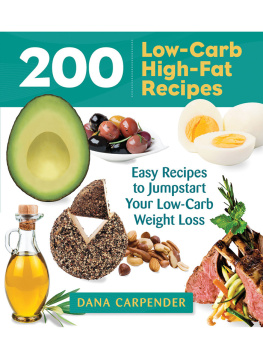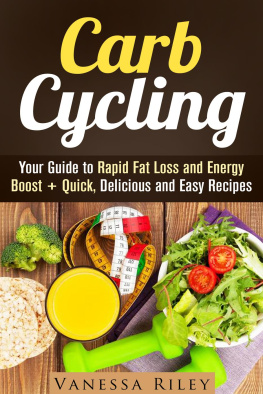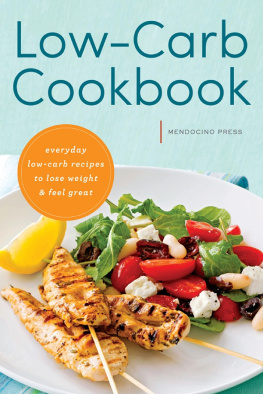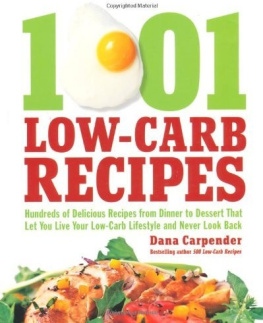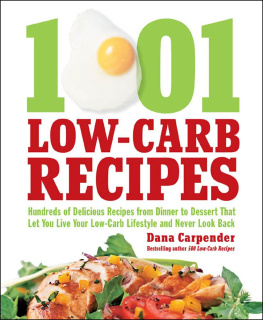Dana Carpender. - 200 Low-Carb, High-Fat Recipes
Here you can read online Dana Carpender. - 200 Low-Carb, High-Fat Recipes full text of the book (entire story) in english for free. Download pdf and epub, get meaning, cover and reviews about this ebook. genre: Science. Description of the work, (preface) as well as reviews are available. Best literature library LitArk.com created for fans of good reading and offers a wide selection of genres:
Romance novel
Science fiction
Adventure
Detective
Science
History
Home and family
Prose
Art
Politics
Computer
Non-fiction
Religion
Business
Children
Humor
Choose a favorite category and find really read worthwhile books. Enjoy immersion in the world of imagination, feel the emotions of the characters or learn something new for yourself, make an fascinating discovery.
- Book:200 Low-Carb, High-Fat Recipes
- Author:
- Genre:
- Rating:5 / 5
- Favourites:Add to favourites
- Your mark:
- 100
- 1
- 2
- 3
- 4
- 5
200 Low-Carb, High-Fat Recipes: summary, description and annotation
We offer to read an annotation, description, summary or preface (depends on what the author of the book "200 Low-Carb, High-Fat Recipes" wrote himself). If you haven't found the necessary information about the book — write in the comments, we will try to find it.
200 Low-Carb, High-Fat Recipes — read online for free the complete book (whole text) full work
Below is the text of the book, divided by pages. System saving the place of the last page read, allows you to conveniently read the book "200 Low-Carb, High-Fat Recipes" online for free, without having to search again every time where you left off. Put a bookmark, and you can go to the page where you finished reading at any time.
Font size:
Interval:
Bookmark:

Easy Recipes to Jumpstart your Low-Carb Weight Loss


Fair Winds Press
100 Cummings Center, Suite 406L Beverly, MA 01915
fairwindspress.com quarryspoon.com

FOREWORD
INTRODUCTION
INGREDIENTS
CHAPTER 1: Nibbly Foods: For Parties or Just for Fun
CHAPTER 2: Sauces
CHAPTER 3: Baked Goods, Cereals, and Other Grainlike Things
CHAPTER 4: Eggs
CHAPTER 5: Side Salads and Dressings
CHAPTER 6: Vegetables and Other Hot Side Dishes
CHAPTER 7: Main-Dish Salads
CHAPTER 8: Beef
CHAPTER 9: Poultry
CHAPTER 10: Pork and Lamb
CHAPTER 11: Seafood
CHAPTER 12: Soups
CHAPTER 13: Sippables
CHAPTER 14: Sweets

Like many people I meet, Danas entree into the low-carb lifestyle began from personal experience. The low-fat diet she had been advised to follow wasnt working and her health reflected it. After years of struggling she ditched the then conventional wisdom and adopted a low-carb diet, lost 45 pounds, dramatically improved her health, and never looked back.
Ill never forget meeting Dana on my first Low Carb Cruise. The Low Carb Cruise is an Annual event which brings together 200-300 low carb enthusiasts (one could say, "zealots") from around the world to learn about low-carbohydrate research and practical advice about living the lifestyle. Once you meet Dana, I doubt that you will ever forget her direct, "just the facts, Maam," style. She tells it like she sees it which makes her cookbooks treasures of practical information. I am grateful to Dana for her prior cookbooksthey have enabled me, my family, and my patients to incorporate healthy low-carb food into our lifestyles.
Why is a clinical research physician and obesity medicine specialist writing a foreword for a cookbook? Because what you eat really matters for your health. I am continually amazed that just by helping people to understand how their bodies respond to what they eat, I can reverse obesity, diabetes, and many other many medical conditions that I used to prescribe medications for as an internal medicine specialist. I can treat, and also prevent, these conditions just by giving advice about how to change the food someone eats. So simple yet so powerful.
As of 2014, the science supports the low-carb, high-fat lifestyle as a healthy way of eating. From my research and clinical practice, I have come to understand that most peoples bodies run better using fat as a fuel instead of carbohydrate (sugars and starches). When you burn fat as your primary fuel and you can do this by eating fat and protein, and low amounts of carbohydrateyour bodys metabolism generates fewer by-products of oxidation, less "exhaust", so to speak. I have spoken about the low-carb, high-fat diet at numerous medical meetings regarding the treatment of obesity, diabetes, metabolic syndrome, polycystic ovary syndrome, and even the "anti-aging" conferences because there are early indications taking sugar and starches out of the diet might slow down the aging process.
The Duke Lifestyle Medicine Clinic was started in 2007 as a natural extension of the research that had been done at Duke University, and then more extensive research happening around the world. My interest in LCHF started as a doctor in a clinictwo of my patients used the Atkins Diet to lose weight, and I thought to myself how easy it would be to use this approach. But, like most physicians, I was skeptical and concerned about the fat in the diet. However if it was indeed safe, I knew that this could be an important tool to treat obesity.
Even today, the most common concern that people express about the low carbohydrate lifestyle is what will happen to their blood cholesterol level by eating all that fat. A whole generation of doctors, dietitians, and the general public were taught that eating fat and cholesterol would raise the bad blood cholesterol and cause heart disease. This was called the "diet-heart hypothesis" and was the theory that spawned the low-fat diet fad. I was privileged to be a part of the recent studies about the LCHF diet. The prediction that LCHF diets would worsen the blood lipid profile didnt come true when they were actually studied. Rather, it revealed that the LCHF diet reduced health risks by lowering the blood triglyceride and raising the good HDL cholesterol. Eating fat raises your good cholesterol!
Today, at the Duke Lifestyle Medicine Clinic, we use the LCHF diet as a therapeutic protocol to reverse most of the chronic medical conditions that are seen today. But LCHF is also a healthy diet that prevents these same chronic medical conditions. My job is to teach LCHF clearly, to taper people off medications as the medical conditions improve, and finally to make sure that people like the foods that they are eating so that they can sustain this way of eating. Because the hunger goes away after a few days of eating LCHF, most people eat less than before, and lose weight if they have excessive fat stores (obesity). The most common reason people come to see me is to lose weight. But LCHF is also excellent as a treatment for diabetes, high blood pressure, gastroesophageal reflux disorder, high blood triglycerides, low blood HDL cholesterol, polycystic ovarian syndrome, irritable bowel disease l am continually learning about problems that can be improved by LCHF. Often the improvements that we see are "unbelievable"meaning that other doctors and experts dont believe it. Weight loss of 200 pounds, lowering of blood triglycerides by 900 mg/dl, increasing the good HDL cholesterol of 50 mg/dLdoctors often are in disbelief, and because the studies havent been published, the researchers say it doesnt exist. However, these are the clinical outcomes that we observe.
As of 2014, the mainstream view is changing the focus from "fat is bad" to "sugar is bad." If youve done any reading about low carbohydrate lifestyles, then you will also know that starches are digested into sugar quite efficientlyso limiting starches is just as important as limiting sugars. Rest assured that your body can rely on fat as a fuel and make all of the daily needs of sugar by itself from the fat and protein that you eat.
Let the LCHF feast begin!
Eric C. Westman, M.D., M.H.S.

Low Carb/High Fat. Wow! How did we get here? After all those rice cakes and bran cereals, all that fat-free milk, it turns out that fatsalbeit the right fatsare far better for us than those healthy whole grains. After a few decades of low-carb being called a high protein diet, were learning that a bit less protein and a bit more fat not only wont make us fat, but that it actually can also make us slimmer and improve our health in the bargain.
It happened to me. Back in 2010, I discovered that, despite my HbA1c (the measure of average blood sugar over the previous three months) being completely normal, my fasting blood glucose was running just a little high, in the pre-diabetic range.
Whats fasting blood sugar? I hear you cry. Its blood sugar tested upon arising, when you have, presumably, been fasting for 8 or more hours. This is obviously significantly different from whats called post-prandial blood sugarblood sugar tested after eating, when you expect blood sugar to be elevated at least a little. The American Diabetes Association considers 2-hour post-prandial blood sugar (taken 2 hours after a meal) of 180 or above to indicate diabetes. Personally, I try not to go above 120 on the advice of Dr. William Davis, cardiologist and author of Wheat Belly. Fasting blood sugar should be lower, of course. Between 70 and 100 is considered normal, 100 to 120 is pre-diabetic, and fasting blood sugar over 120 is a marker of diabetes. My post-prandial blood sugar was invariably golden, but my fasting blood sugar was generally between 105 and 110; I even saw it at 119 one day.
Font size:
Interval:
Bookmark:
Similar books «200 Low-Carb, High-Fat Recipes»
Look at similar books to 200 Low-Carb, High-Fat Recipes. We have selected literature similar in name and meaning in the hope of providing readers with more options to find new, interesting, not yet read works.
Discussion, reviews of the book 200 Low-Carb, High-Fat Recipes and just readers' own opinions. Leave your comments, write what you think about the work, its meaning or the main characters. Specify what exactly you liked and what you didn't like, and why you think so.

